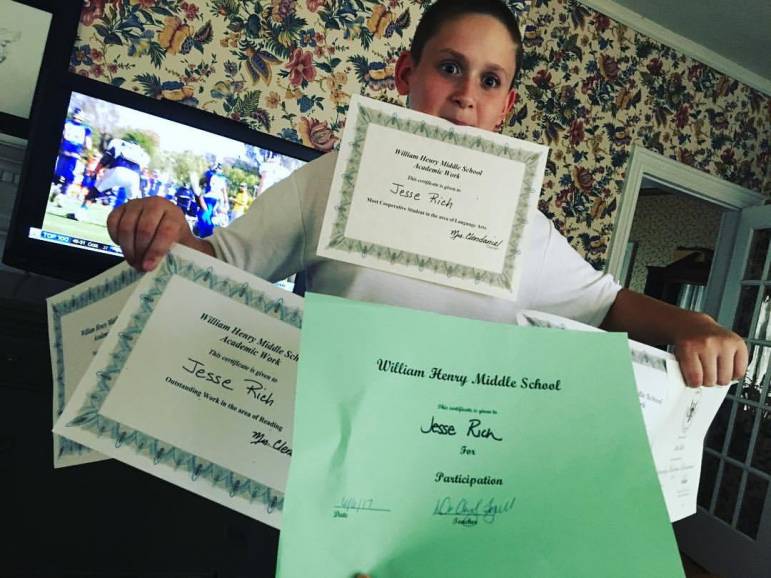
 Now that we’ve talked about punishment, let’s talk about the more positive side of parental discipline – using rewards. When we reinforce our children, we get the delightful opportunity to speak nicely to them about how proud we are of their behavior, and sometimes to give them an unexpected gift or surprise. If you are a person who finds it hard to punish, you are most likely in love with rewards. You get to be the good guy, the buddy, the supporter and biggest fan of your child. And you can often see the joy in your child’s eyes when they hear your praise and feel your hugs and kisses. What a great reward we give ourselves when we reward our children for positive behavior! I call this the joy of reinforcements.
Now that we’ve talked about punishment, let’s talk about the more positive side of parental discipline – using rewards. When we reinforce our children, we get the delightful opportunity to speak nicely to them about how proud we are of their behavior, and sometimes to give them an unexpected gift or surprise. If you are a person who finds it hard to punish, you are most likely in love with rewards. You get to be the good guy, the buddy, the supporter and biggest fan of your child. And you can often see the joy in your child’s eyes when they hear your praise and feel your hugs and kisses. What a great reward we give ourselves when we reward our children for positive behavior! I call this the joy of reinforcements.
Some of you, however, may be the opposite kind of person. You may feel more comfortable with the punishing, while the rewarding may seem more unnatural. If I had to guess, you were raised in a very punitive household, and the lesson you learned was “spare the rod, spoil the child.” Remember that I am not anti-punishment (although I am anti-rod!). However, all of the research on behaviorism suggests that punishment alone is not enough to mold a full human being.

Humans have many needs, one of which is the need for esteem. If your daughter does not hear positive words from you, she will seek positive regard from others the rest of her life. If your son never hears that you are proud of him, he will seek approval from others for the rest of his life. I wish to reiterate what we have discussed previously – just because your parents did it, doesn’t mean it was the best way to get it done. It is up to you, in the process of reading this here and now, to make decisions about the kind of parent you want to be, and the kind of child you want to help create. Punishment is necessary, yes, but even more so, your child must experience positive results for positive behavior. Using rewards is the method for doing just that.
We are not trying to create timid children, whose main goals in life are to avoid punishments. We want to create children who are confident, bold, and self-assured. The source of these qualities in adulthood is how the parents talked to them when they were children. As author Peggy O’Mara has famously said, “The way we talk to our child becomes their inner voice.”
To that end, the majority of your parenting should be a combination of modeling ethical behavior, engaging in solid communication about positive behavior and using rewards to teach your child what good behavior you want to encourage. And go heavy on the reinforcement. Any time you have a chance to express your pleasure with your child, his behavior, and the wonderful person that he is, you should take the time to do it. My 13 year old son is almost at the point where he thinks he is too cool to let me kiss him and speak compliments in his ear. But I don’t care. The words and the kisses are still getting through, even if he has to front like he doesn’t want it.
Your child wants to make you happy. It is your job to teach her how to do that. On the reinforcement side of our behaviorist platform, the way to quietly, calmly mold your child into the person you want him to be is through the use of shaping. Using shaping to change behavior involves breaking up what you want your child to be able to do into smaller sub-goals that are accomplishable. You want to give your child as many opportunities to be rewarded and praised as possible. This will improve your relationship with your child, and also build your child’s skills in ways that are not clouded by frustration.
Some examples
Let’s discuss some examples of shaping in everyday life: My oldest son, who had not shown any interest in athletic activity for 12 full years, all of a sudden expressed an interest in having a catch with a football. I remember being young and playing football outside with my friends, and I was delighted to have the chance to go back out and do it again.
Throughout the years, my wife and I had created an expectation that our children would always be involved in some kind of physical activity, in order to teach them that exercise was important. However, we never forced them to do any specific sport or hobby. It was up to them to try different things out (there was swimming, tennis, soccer, baseball, running, biking, Frisbee), with the idea that one day, they would find something they wanted to stick with. Until they did, however, it was perfectly fine for them to switch from one thing to another.
In other words, we had a goal to teach our children the importance of physical activity. We didn’t have a goal to teach our children to play soccer, or be swimmers. From there, we moved backwards toward our objectives. We wanted to: 1) model physical activity ourselves, so that our children knew that we really did value it with our deeds as well as our words; 2) introduce them to a variety of options for being physically active; 3) commit to using rewards in response to their efforts, so that they would want to try their best and perhaps to improve.
Notice that the goals and objectives say nothing about how good they would be at their chosen activities. We focused on getting them to explore and try different methods of exercise, rather than on winning and competing. Now, as a man, I have to admit that I have sometimes gotten carried away with my enthusiasm when one of them wins or excels, but I do try to eventually remind them that, even if they play baseball and strike out every time, I still love them and their success or lack thereof in sports has nothing to do with that love.
Back to football: Without even thinking too much about it, I just naturally started out with a Nerf football (which wouldn’t be as difficult to catch). We stood fairly close together, and threw the ball underhand to one another. My son needed to first learn to catch, before he could catch anything difficult. When he dropped it, I said things like, “Ohhh! You almost got that.” Or, “No problem. Everyone misses some catches.” And when he caught it, I said, “Wow. That’s it!” Or, “That’s a great catch.” Simple praises from his father that your son or daughter will love to hear from you. We did that for a while, and let that be it. When I could see that he was getting bored or frustrated, I would say, “Ok. Let’s get three more catches, and then we’ll go in and have a snack.” This motivates him to get refocused, gives me three more opportunities to praise him, and then he gets rewarded for his effort with a snack. When we’re having that snack, we are recounting his catches and misses, and I am telling him that I am proud of him for his effort, and telling him what a good time I had. Trust me, when you speak this way to your child, giving him your undivided attention, it is like honey to a bear. If you’re like me, it’s equally rewarding for both of us to set aside this time and fill it with positive regard.
After we played catch with the Nerf ball standing 10 yards apart, and he could catch almost everything, we backed up a little more and threw from a further distance, and the process of using rewards, giving feedback and having fun begins again. Until that was too easy. And then, 20 yards apart. Then, we started introducing simple running patterns, where he had to catch passes that I threw to him while he was running. That took a long time. Each step along the way is what psychologists call a “successive approximation,” meaning you are gradually building toward an ambitious goal, taking baby steps along the way. As each stage is mastered, the rewards require another challenge to be attempted.

My son is almost 14 now, and is practicing with the Freshman team at his high school. We go out several times a week and still have a catch. He can run difficult patterns, catch an official sized leather ball with one hand a decent percentage of the time, throw a nice looking spiral, and defend other receivers from catching the ball. It’s gotten to the point where I can throw the ball straight at him 10 yards away, as hard as I am able to throw it, and he can catch it with a nonchalant look on his face.
Important point: The very first day, when he said he wanted to have a catch, I didn’t grab an official sized NFL leather football, set him up 10 yards away, and throw it at him as hard as I could throw it. There’s no way he would be able to do it, he’d probably get hurt, and, using Thorndike’s Law of Effect as a guide, he’d react to our catch as if he’d been punished for trying. I’d guess he would not like football very much if I had started that way.
So now, this story is a guide for how we can teach our children almost anything that they are eventually capable of doing. If you want your child to know how to do the dishes, you can’t fill the sink up, and then tell her to “do the dishes.” She won’t know how to do it properly, you will be disappointed and perhaps critical, and the whole experience will create distance between the two of you. You have to show her how to do it, then maybe give her a fork to clean off, and praise her for it if it was done well. If it wasn’t done well, show her what she missed (calmly), and then show her how to fix it. Then, give her another fork and let her try again. You are looking for opportunities to praise your child, creating small challenges that she can meet, so that you are brought closer together with your positive regard.
Stay on the forks for a while until she gets it, then move on to all the silverware. Or, you clean and teach her how to rinse or dry. Or, give her the plates if that’s an easier item for you to teach. It doesn’t matter which way you start, as long as you start small, do it together, and are regularly using praise and rewards to make it more likely that she will walk away feeling good about herself as a result.
Creating mastery experiences
On a side note, the reason the concept of shaping is so effective in teaching your child a new skill is because it acknowledges the limits of our working and short-term memory. When our brain is learning something new, it dedicates a lot of “muscle” to the endeavor. When my son is learning how to catch a football for the first time, he has to simultaneously learn how to judge the speed of the ball, how to hold his hands, how to grasp the ball once it has reached his body, and how to hold onto it. If I add to that the necessity of avoiding danger (because I am throwing it too hard), or of judging height and gravity (because I threw it high up in the air), I am taxing the capacity of the brain to calculate everything involved and there is a high likelihood of failure. We don’t want failure – we want success, however small it has to be defined.
In my article on teaching my son to ride a bike, I talk about how I took the pedals off the bike so that he could focus on his balance before he had to simultaneously learn how to turn the pedals, worry about how to brake, and how to keep himself from falling. This is the same thinking. Whatever you can do to make learning a new skill more manageable, you should do it. In the world of education, this is called “creating mastery experiences.” The more mastery experiences we have, the more we feel that we can accomplish whatever we decide to pursue. How many times have you heard that as a lesson we should be teaching our children? Is that one of your goals for your parenting and your children? If it’s not, feel free to add it. And then, under objectives, make a note to use shaping when you teach your children new things.
This takes time! You might be thinking, I can do the dishes faster by myself. Right now, you can. But after you’ve shaped her skills so that she can do the entire sinkload, you can sit back, let her do it, and all you have to do it express your gratitude for her help. Additionally, the extra time you are spending together as you teach her is a time for the two of you to bond, a time for you to practice communicating, using rewards, and loving your child into adulthood.
To that end, it is important to revisit our goals as parents and our goals for our children.
Activity
Write down each of your goals for your children. What are some “sub-goals” that you can see as necessary approximations of the main goal? Next to each of these sub-goals, think of a behavior that your child does that reflects the sub-goal that you can more frequently reward. What kind of reward will you use? How often? How will you communicate the reason for the reward?

Dr. John D. Rich Jr. is an associate professor of Psychology at Delaware State University, a retired United Methodist minister, a full-time husband and father of two sons. You can hear Dr. John every other Wednesday at 4:30 p.m. on the Matt Connarton Unleashed radio show on WMNH 95.3 FM. Also, check out drjohnrich.com for more info. Got questions? Dr. John will help you navigate. Reach him directly at info@drjohnrich.com.







